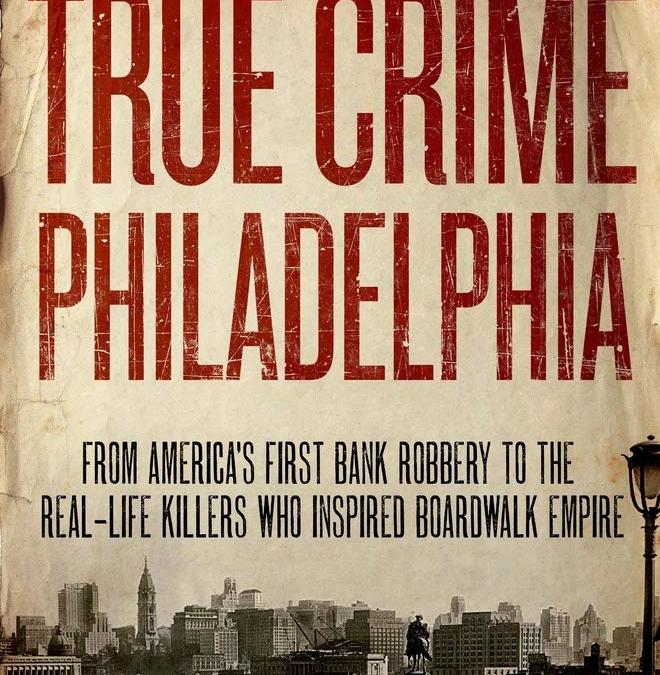Philadelphia is known as a “city of firsts.” Philadelphia was the first planned city in America. Philly had the first stock exchange, first penitentiary, first Thanksgiving Day parade, and so on.
Philadelphia also has the dubious distinction of having the first kidnapping and the first bank robbery. These stories and others about early crime in Philly are told vividly in Kathryn Canavan’s “True Crime Philadelphia: From First Bank Robbery To the Real-Life Killers Who Inspired Boardwalk Empire.”
I reached out to Canavan and asked her why she wrote the book.
“An editor from Lyons Press asked if I’d be interested in researching the true crime history of Philadelphia,” Canavan replied. “There were three centuries of heroes and villains and vexing characters.”
How would you describe the first bank robbery?
“One of the most interesting things about the robbery is that the bank was in the basement of Carpenters’ Hall where the First Continental Congress was held 34 years earlier. The story takes on more urgency because it all happened in August 1798, just as people were fleeing the city because yellow fever was rampant,” Canavan said. “One of the two thieves succumbed to the fever before he could spend his half of the money and the other one helped himself to both halves.”
How would you describe America’s first kidnapping?
“The kidnapping of Charley Ross is the most sensational crime in Philadelphia history to this day. Up until that day in Germantown no American child had ever been kidnapped for ransom. No parent ever worried it would happen,” Canavan said. “There was a popular song about Charley. He was written into a Broadway play. His case inspired the admonition, ‘Never take candy from a stranger.’ Before the kidnapping, parents weren’t wired to be on the alert for someone trying to take their children. No police officer had ever been assigned a ransom case.”
Canavan said her favorite story in the book is the 1926 Olney Bank and Trust robbery, a daring daylight stickup.
“Four heavily armed bandits were already driving away with the loot – almost $1.2 million in today’s money – when the people of Philadelphia put their thumb on the scale,” Canavan said. “They borrowed guns and knives and ran into the bullets to help the sole police officer on the scene. A mechanic, a night watchman and a poultry salesman, all strangers until that morning, decided to tail the robbers together. Two men laying a gas pipe decided to give chase instead. A man who had been trying to sell his touring car drove it into the gunfight instead.”

One of the most interesting stories in the book is the largest mass murder plot in U.S. history.
“It was the largest murder case in city history. The ring’s standard tools were hexes, love potions, the evil eye and arsenic sprinkled on spaghetti. When they ran out of arsenic, they resorted to bludgeoning with sandbags, ill-fated fishing trips and hit-and-run accidents. They even tried to buy live typhoid germs. Their goal was to collect life insurance payouts, and police estimated the ring netted nearly $100,000 during the Depression. Their partners in crime were unhappy homemakers who would insure their husbands,” Canavan said. “The ring had its own doctors, undertakers, insurance agents and even a matchmaking service for arsenic widows.”
Canavan said that 27 suspects were convicted and 15 served life sentences. Two cousins went to the electric chair.
How would you describe serial killer H.H. Holmes?
“Holmes is a man who would murder his own business partner for insurance money and then kill three of the man’s children to get all the heirs out of the picture,” Canavan said. “He was married to three women at the same time.”
Canavan said he was caught and hanged here at Moyamensing Prison due to efforts of a Philadelphia detective named Frank Geyer.
“Even celebrated crooks like H.H. Holmes were no match for everyday Philadelphians. Clever, everyday Philadelphians have been tripping up criminals for more than 300 years,” Canavan said. “When civil rights leader Octavius Catto was assassinated on South Street, a 61-year-old brickmaker jumped off a trolley car and chased down the 21-year-old shooter. The bandits who robbed the Olney Bank and Trust branch were already driving away with the money bags from the most lucrative holdup in city history when fearless Philadelphians stepped up and stopped them.”
Canavan added that it was a passerby who spotted bank robber Willie Sutton just 180 seconds after he tunneled out of Eastern State.
“Philadelphians are a resourceful bunch, whether committing crimes or stopping them.”
Paul Davis’ Crime Beat column appears here each week. You can contact him via pauldavisoncrime.com.





